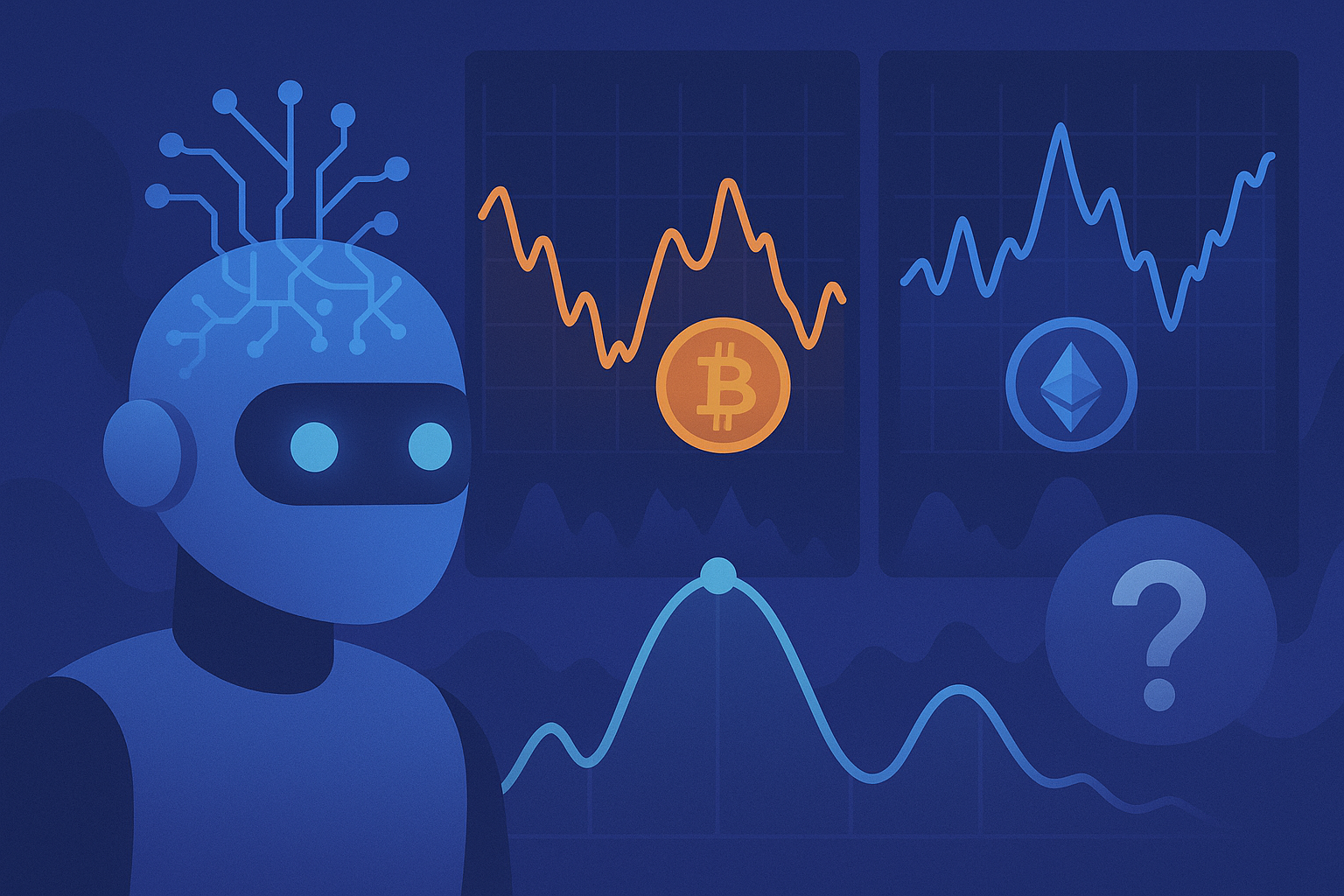How AI Trading Bots Work: Strategy, Safety & Setup December, 2025
AI trading bots are reshaping crypto by automating strategies, analyzing vast data, and enforcing discipline. This guide explains how they work, their risks, and how to set them up safely.
 Written by Nikolas Sargeant
Written by Nikolas Sargeant
Crypto never sleeps, and neither do the markets that move it. Prices can swing double-digits in minutes, liquidity migrates across exchanges in real time, and news or social sentiment can flip the narrative before you’ve finished your coffee. That 24/7 volatility is why so many traders turn to automation. Enter AI trading bots: software agents that read market data at machine speed, look for patterns humans might miss, and execute pre-defined strategies without hesitation or emotion.
But “AI bot” is a broad label. Some tools are little more than rule-based scripts dressed up with buzzwords; others incorporate machine learning to adapt to changing conditions, fuse price action with alternative data (like funding rates or sentiment), and learn from both successes and mistakes. Used well, they can help you systematize discipline, scale your attention across pairs and venues, and test strategies before risking serious capital. Used poorly, they can just as quickly amplify bad assumptions, overfit to yesterday’s market, or expose you to operational and security risks.

This guide breaks the topic into three practical questions: how AI trading bots work, how traders actually use them (strategy), and how to set them up safely (security and risk management). We’ll walk through the mechanics, data inputs, modeling approaches, backtesting, and live execution, then examine the core strategies bots tend to run (trend following, market making, arbitrage, sentiment-driven systems, and portfolio rebalancing). Finally, you’ll get a step-by-step setup process, a safety checklist you can apply immediately, and a look at what’s next (multi-agent systems, explainability, and DeFi integrations).
Two quick ground rules as you read: (1) No bot guarantees profits, markets change, and risk is real. (2) Treat AI as a co-pilot, not an autopilot, human oversight, risk limits, and iteration matter. If you keep those in mind, you’ll be positioned to evaluate tools rationally, avoid common pitfalls, and build a workflow that fits your goals, risk tolerance, and technical comfort.
What Are AI Trading Bots?
At their core, AI trading bots are software programs that ingest data, decide on trades according to a learned or specified policy, and execute orders via exchange APIs. They differ from traditional algorithmic bots in one key way: instead of following fixed if-this-then-that rules only, AI-enabled systems incorporate learning, they can adapt parameters, recognize evolving patterns, or even discover new signal combinations over time.
Key Building Blocks
- Data Feeds: Price, volume, order-book depth, funding rates, on-chain metrics, and sometimes alternative data such as news or social sentiment. Clean, timely data is non-negotiable.
- Signal Generation: Models transform raw data into tradeable signals—e.g., probability of an upward move in the next N minutes, or an expected spread reversion. AI systems may use supervised learning (predict returns), reinforcement learning (optimize actions via reward), or hybrid methods.
- Risk & Execution Layer: Position sizing, stop-loss logic, take-profit targets, and order-type selection (market, limit, post-only). Good bots consider slippage, fees, and liquidity.
- Monitoring & Governance: Live dashboards, alerts, health checks, and kill-switches. A serious setup assumes things will break and designs for graceful failure.
AI vs. Traditional Algo Bots
- Traditional algos: Deterministic rules (e.g., “if 50-EMA crosses above 200-EMA, buy”). They’re transparent and easy to audit but may struggle when regimes change.
- AI-driven bots: Learn relationships in data (e.g., non-linear interactions among indicators, order-book features, and sentiment). They can adapt, but they’re more complex, risk overfitting, and require stronger validation and monitoring.

Where Traders Use Them
- Retail: Off-the-shelf platforms offering prebuilt strategies with configurable parameters; marketplace templates; copy-trading variants; or lightweight DIY frameworks.
- Advanced Retail / Prosumer: Semi-custom setups that combine vendor tooling with user-defined models, cloud deployment, and continuous integration for backtests and updates.
- Institutional / Quant Funds: Fully custom research pipelines, proprietary data, robust risk systems, and strict change management.
What They Are Not
AI bots are not magic money machines. They don’t eliminate drawdowns, and they can’t foresee “unknown unknowns.” They’re tools for process, not shortcuts to guaranteed gains. The right mindset is system design + risk control + iteration.
How Do AI Trading Bots Work?
At a high level, AI trading bots transform streams of market data into trading decisions, and then execute those decisions automatically on an exchange. Under the hood, this process involves three main layers: data collection, modeling/decision-making, and execution.
Step 1: Data Collection & Inputs
AI bots are only as good as the data they ingest. Typical inputs include:
- Market data: Price, volume, bid-ask spreads, depth-of-book, volatility indices.
- Derived indicators: Moving averages, RSI, MACD, Bollinger Bands, etc.
- On-chain data: Wallet flows, token transfers, staking metrics.
- Alternative data: News sentiment, Twitter trends, Reddit discussions, or even Google search volumes.
Unlike rule-based bots, AI-driven bots can combine dozens (or hundreds) of features simultaneously, identifying correlations humans might miss.
Step 2: Signal Generation via AI Models
Once the data is in, the AI model processes it to predict outcomes or optimize decisions.
- Supervised learning: Train on labeled examples (e.g., past price moves) to predict whether an asset is likely to rise or fall.
- Reinforcement learning (RL): Treat trading as a game. The bot “tries” actions (buy/sell/hold) in a simulated environment, learns which sequences maximize long-term reward, and adapts its policy.
- Unsupervised learning: Cluster assets by behavior (e.g., correlation or volatility regimes), useful for portfolio strategies or anomaly detection.
For example, a reinforcement learning bot might learn that in volatile sideways markets, scalping small spreads yields better risk-adjusted returns than trend-following.

Step 3: Decision-Making Logic
AI models don’t trade blindly—they sit inside a risk-aware framework.
- Position sizing: Decide how much to allocate per trade (fixed % of capital, volatility-adjusted, Kelly-style sizing).
- Risk filters: No trades if volume is too low, or if bid-ask spread exceeds a set threshold.
- Portfolio rules: Ensure exposure across assets doesn’t exceed limits.
This layer prevents the model from making reckless trades even if the raw signal suggests “buy.”
Step 4: Execution Engine
Once a decision is made, the bot must place trades quickly and efficiently.
- API connectivity: Bots use secure API keys to connect with exchanges like Binance, Coinbase, Kraken.
- Order types: Market orders for speed, limit orders for reduced slippage, or advanced orders (stop-limit, post-only).
- Latency handling: Especially important for arbitrage and market-making strategies where milliseconds count.
Execution is where many retail bots fail—poor handling of liquidity, slippage, or API downtime can wipe out the edge.
Step 5: Feedback & Adaptation
Unlike static algos, AI bots can retrain or update parameters as they encounter new data. For instance:
- If volatility spikes, a bot may reduce position sizes.
- If its win-rate drops over a rolling window, it can trigger a self-audit or switch to fallback strategies.
The cycle is continuous: collect data → generate signals → execute → learn → adjust.
Putting It Together: Example Workflow
Imagine an ETH trading bot running on Kraken:
- Pulls price, order-book depth, and Twitter sentiment every 5 seconds.
- Model predicts a short-term upward move with 70% confidence.
- Risk filter checks: volume > threshold, exposure < 10% of portfolio.
- Bot places a limit order slightly below current ask.
- Order fills; stop-loss auto-placed 2% below entry.
- Bot monitors; if model confidence drops or stop triggers, it exits.
- Performance logged; bot adjusts thresholds for future trades.

Strategies Used by AI Trading Bots
AI bots aren’t all built the same. While the underlying mechanics—data in, decision out—stay constant, the strategies they implement can vary widely. Here are the most common approaches traders use today:
1. Trend Following
- Concept: Identify when a market is moving consistently upward or downward and ride that wave.
- How AI helps:
-
Learns optimal moving average periods rather than relying on arbitrary 50/200-day windows.
-
Detects regime shifts (e.g., strong momentum vs. choppy sideways action).
-
- Example: A bot spots ETH’s 30-minute EMA trending above its 200-minute EMA while sentiment indicators are positive. It increases long exposure until the model predicts weakening momentum.
Trend-following bots are particularly effective in crypto because the asset class tends to move in strong, extended cycles.
2. Arbitrage
- Concept: Exploit price differences between venues or assets.
- Types:
-
Cross-exchange arbitrage (buy ETH cheaper on Kraken, sell higher on Binance).
-
Triangular arbitrage (profit from pricing inefficiencies within one exchange using three trading pairs).
-
How AI helps:
-
Detects fleeting opportunities in milliseconds.
-
Optimizes for fees, latency, and liquidity.
Example: A bot monitors BTC/USDT across five exchanges, auto-executes when spreads exceed 0.4% net of fees, and cancels instantly if liquidity vanishes.
Because arbitrage windows often last seconds, AI’s speed and ability to parallel-process are critical.
3. Market Making
- Concept: Provide liquidity by posting buy and sell orders, profiting from the spread.
- How AI helps:
-
Dynamically adjusts spreads based on volatility and order-book imbalances.
-
Avoids “toxic flow” by withdrawing when a sudden move is detected.
-
Example: A bot places staggered buy/sell orders around BTC’s current price. When volatility spikes, it widens its spread to protect against losses.
Market-making requires robust risk controls, but AI models can optimize profitability while reducing exposure to sudden moves.

4. Sentiment-Driven Trading
- Concept: Use non-price signals (news, social media, funding rates) to predict short-term moves.
- How AI helps:
-
Natural Language Processing (NLP) scrapes headlines, tweets, Reddit posts, and classifies sentiment.
-
Correlates spikes in optimism or fear with probable market reactions.
-
Example: Dogecoin sentiment spikes on Twitter following a viral post. The bot detects an above-average surge in positive sentiment and enters a short-lived long position, exiting once momentum fades.
These bots thrive in meme-driven environments but must be carefully filtered to avoid false signals.
5. Portfolio Rebalancing
- Concept: Maintain a target allocation across multiple assets, adjusting when allocations drift.
- How AI helps:
-
Predicts correlations and volatility, suggesting more efficient portfolio mixes.
-
Executes incremental trades to minimize slippage.
-
Example: A portfolio bot aims for 40% BTC, 30% ETH, 30% AI tokens. When ETH rallies and exceeds 40% of the portfolio, the bot trims ETH and redistributes into BTC/AI tokens to restore balance.
This strategy is popular among long-term investors who want systematic discipline without micromanaging.
6. Hybrid & Adaptive Systems
Many advanced setups combine strategies:
- A trend-following model may be “gated” by sentiment analysis.
- A market-making bot could use reinforcement learning to adapt spreads based on volatility regimes.
- Multi-agent frameworks deploy several specialized bots that coordinate (e.g., one arbitrage agent, one hedging agent, one portfolio agent).
Key Takeaway
Each strategy has pros and cons:
- Trend following captures momentum but suffers in sideways chop.
- Arbitrage is low-risk in theory but heavily competed.
- Market making earns steady returns but can be crushed by sudden volatility.
- Sentiment trading can be profitable but noisy.
- Rebalancing preserves discipline but doesn’t maximize returns.
The smartest AI traders often blend strategies, using AI not just to execute but to decide which strategy is most appropriate under current conditions.
Benefits of AI Trading Bots
AI trading bots aren’t just about trading faster — they’re about trading smarter, more systematically, and with less emotional drag. Here are the core advantages that keep both retail traders and institutional desks investing in this technology:

1. 24/7 Automation
Crypto markets don’t close. While humans need to sleep, bots can monitor hundreds of pairs across multiple exchanges without interruption. An AI bot doesn’t just run on autopilot — it adapts in real time, ensuring you never miss opportunities while avoiding burnout.
2. Emotion-Free Trading
Fear and greed are the downfall of many traders. AI bots stick to data-driven rules, ignoring panic selling and FOMO buying. By removing emotional bias, they enforce discipline that even seasoned professionals can struggle to maintain.
3. Ability to Process Massive Data Sets
Traditional discretionary traders may watch a handful of indicators. An AI bot can analyze hundreds of features simultaneously: price action, order books, volatility indices, and even social sentiment. This gives a broader and often more nuanced picture of market conditions.
4. Adaptive Learning
Where traditional bots stick to fixed strategies, AI bots can learn and evolve. Reinforcement learning agents, for instance, adjust their policies as conditions change — reducing exposure in sideways markets, increasing risk-taking during strong trends, or switching strategies altogether when volatility spikes.
5. Backtesting & Simulation
AI trading frameworks allow for robust testing across years of historical data. This lets traders evaluate potential strategies before risking real capital. Bots can also simulate “what-if” scenarios (e.g., how a strategy would have performed during the March 2020 crash).
6. Accessibility for All Levels
- Retail traders can plug into off-the-shelf platforms with low technical barriers, accessing bot marketplaces or copy-trading AI agents.
- Institutional desks can customize models, integrate proprietary data streams, and deploy fleets of bots across exchanges with risk oversight.
This democratization means the same technology that powers hedge funds is, at least in some form, available to individuals.

7. Consistency Over Time
Humans tire, get distracted, or deviate from their own rules. Bots execute the same logic with unwavering consistency — provided they’re coded and monitored correctly. For strategies that rely on long-term discipline, this reliability is invaluable.
Bottom Line
The benefits of AI bots lie in discipline, scale, and adaptability. They don’t guarantee profits, but they do give traders tools to systematize decision-making and manage complexity in markets that are simply too fast and too global for humans to handle alone.
Risks and Limitations of AI Trading Bots
AI bots can give traders a real edge — but they’re far from foolproof. In fact, many losses in crypto come from blindly trusting automation without understanding its limitations. Here are the main risks to be aware of:
1. Overfitting & Poor Backtesting
- The risk: An AI model can be trained to perform brilliantly on historical data but fail in live markets. This is called overfitting — the bot has essentially “memorized” the past instead of learning patterns that generalize.
- Mitigation: Use out-of-sample testing (test on unseen data), walk-forward analysis, and stress-testing on extreme historical events.
2. Market Shocks & Black Swan Events
- The risk: Bots are good at finding patterns — but sudden, unpredictable events (exchange hacks, regulatory bans, wars, tweets from influential figures) can crush them. During black swans, bots can amplify losses by executing bad trades rapidly.
- Mitigation: Always use hard stop-losses, set maximum drawdown limits, and have a manual “kill switch” in case markets behave irrationally.

3. Technical & Infrastructure Risks
- The risk: Bots rely on exchange APIs, internet connections, and sometimes cloud hosting. Any downtime, lag, or mis-synced order books can lead to missed trades or worse — duplicate/erroneous trades.
- Mitigation: Use reliable hosting, monitor API health, and build in error-handling logic (retry orders, cancel stale orders).
4. Security Vulnerabilities
- The risk: Bots need API keys to access your exchange account. If those keys are compromised, hackers can drain funds or execute malicious trades.
- Mitigation: Restrict API permissions (disable withdrawals), use IP whitelisting, rotate keys regularly, and choose platforms with strong security reputations.
5. Regulatory & Legal Gray Areas
- The risk: In some jurisdictions, using automated bots may fall into regulatory blind spots. Taxation, reporting, or compliance issues can arise if your bot engages in activities regulators don’t fully recognize.
- Mitigation: Stay updated on local laws, report trades accurately, and avoid services that promise guaranteed returns (a common scam red flag).
6. Psychological Over-Reliance
- The risk: Perhaps the least discussed danger: traders may become overconfident once they deploy a bot. Instead of monitoring performance and improving strategy, they “set and forget,” assuming the AI will handle everything.
- Mitigation: Treat bots as tools, not replacements. Monitor performance, refine regularly, and always maintain manual oversight.
Bottom Line
AI bots are powerful but imperfect. They can compound bad assumptions as easily as good ones, and small technical oversights can lead to big losses. The safest approach is to combine them with human supervision, diversified strategies, and strict risk management.

Setting Up an AI Trading Bot: Step-by-Step
Deploying an AI trading bot doesn’t have to be intimidating. Whether you’re using an off-the-shelf service or building your own, the setup process generally follows the same sequence. Here’s a step-by-step playbook you can adapt:
Step 1: Define Your Trading Goals
Before touching software, get clear on your objectives:
- Are you looking for short-term active trading (scalping, arbitrage)?
- Or long-term portfolio optimization (balancing BTC, ETH, altcoins)?
- How much capital are you comfortable risking?
Clarity here prevents you from mismatching your goals with the wrong bot or strategy.
Step 2: Choose a Platform or Provider
You have three main options:
- Exchange-integrated bots (e.g., Binance, KuCoin) – easy setup but limited strategies.
- Third-party platforms (e.g., Kryll, 3Commas, Shrimpy) – marketplaces of strategies, some AI features.
- DIY frameworks (e.g., TensorTrade, backtrader + custom ML models) – maximum flexibility, but technical skills required.
Evaluate platforms based on costs, transparency, supported exchanges, and security.
Step 3: Configure Strategy
This is where AI meets your goals:
- Select or design indicators (EMA crossovers, volatility bands, sentiment scores).
- Define parameters: risk per trade, max open positions, leverage (if any).
- If AI-driven, specify the model inputs (price data only? sentiment too?).
Pro tip: Start simple. Complexity without understanding usually hurts performance.

Step 4: Backtest & Optimize
- Run your bot on historical data to see how it would have performed.
- Test across different market regimes (bull, bear, sideways).
- Beware of overfitting (don’t let the model just memorize past data).
A good backtest includes: win-rate, profit factor, max drawdown, Sharpe ratio.
Step 5: Deploy with Small Capital
- Connect your bot to a live exchange via API keys (always restrict withdrawal permissions).
- Start with paper trading (simulated) or a tiny real allocation.
- Monitor behavior closely — does execution match expectations?
Think of this as a beta test before scaling.
Step 6: Monitor & Adjust
Even after launch, your job isn’t done:
- Track key metrics: ROI, drawdowns, error logs.
- Adjust parameters or retrain AI models when performance drifts.
- Keep manual override controls available at all times.
Quick Safety Checklist
- Secure your API keys (restricted + IP whitelist).
- Diversify across assets and strategies.
- Cap maximum allocation per trade.
- Keep logs of every executed order.
- Have a manual kill switch ready.
Example: A Beginner Setup
Imagine Alice, a retail trader with $2,000:
- Defines her goal: steady growth with low risk.
- Chooses a platform like 3Commas with marketplace AI bots.
- Configures a trend-following strategy with 2% risk per trade.
- Backtests against 2021–2023 BTC data.
- Deploys with $200 (10% of her portfolio).
- Monitors for one month, then scales up if performance matches expectations.
Bottom Line
Setting up an AI trading bot is less about flipping a switch and more about carefully layering design, testing, and monitoring. The good news: once your workflow is in place, most of the heavy lifting becomes automated — leaving you with oversight instead of constant micro-decisions.
Safety & Best Practices
Trading bots can be powerful allies, but only if you run them safely. Here’s a set of best practices that apply whether you’re a retail beginner or an advanced trader deploying custom AI systems.
Security First
- Restrict API keys: Never enable withdrawal rights; keep trading permissions only.
- Use IP whitelisting: Limit bot access to specific IP addresses.
- Rotate keys regularly: Treat API keys like passwords—don’t keep the same ones forever.
- Pick trusted platforms: Avoid providers promising “guaranteed profits.”

Start Small, Scale Slowly
- Begin with paper trading or tiny allocations.
- Increase position size only after months of consistent results.
- Think of bots as tools for scaling discipline, not shortcuts to instant wealth.
Diversify Strategies
- Don’t put all capital into one bot or one strategy.
- Mix approaches (trend-following, arbitrage, portfolio rebalancing).
- Diversification reduces the risk of one bad strategy wiping out your funds.
Monitor Performance
- Set up alerts and dashboards to track bot health in real time.
- Regularly check logs to ensure orders are executing as expected.
- Use max drawdown alerts—if losses exceed a set percentage, the bot auto-pauses.
Stay Compliant
- Understand the legal status of trading bots in your jurisdiction.
- Keep detailed logs for tax reporting.
- Be cautious with third-party platforms that may operate in regulatory gray zones.
Maintain Human Oversight
- Always keep a manual kill switch handy.
- Review bot behavior weekly, not yearly.
- Treat AI as a co-pilot, not an autopilot.
Quick Safety Checklist
- Secure API keys (no withdrawals)
- Limit capital allocation per trade
- Monitor performance dashboards
- Manual override ready
- Stay updated on regulations
Bottom Line
Bots can amplify profits, but they can also amplify mistakes. Safe deployment is about control, oversight, and incremental scaling. The traders who succeed with AI are the ones who treat safety as part of the strategy, not an afterthought.
The Future of AI Trading Bots
AI trading bots are already transforming how markets operate, but the next wave promises to be even more disruptive. Looking ahead, several trends stand out:
Multi-Agent Systems
Instead of one monolithic bot, traders will increasingly deploy swarms of specialized agents. One bot might monitor sentiment, another handle execution, another rebalance portfolios. Together, they form a coordinated ecosystem — dividing tasks for greater efficiency. Early research shows multi-agent frameworks can outperform single strategies by adapting in real time to different market conditions.

DeFi Integration
Most bots today focus on centralized exchanges. But as decentralized finance (DeFi) matures, bots are beginning to interact directly with on-chain protocols. Imagine AI agents that:
- Detect liquidity pool imbalances.
- Execute flash-loan arbitrage.
- Optimize yield farming allocations dynamically.
This shift will blur the line between quant trading and smart contract automation, giving rise to hybrid strategies that live entirely on-chain.
Explainable AI in Finance
One of the major barriers to adoption is trust. Traders (and regulators) are wary of “black box” AI. The next generation of bots will emphasize explainability: instead of just making trades, they’ll justify decisions in plain language or dashboards (“This trade was executed because momentum and sentiment aligned with historical profitable setups”). Transparency will make AI bots more accessible and compliant.
Broader Market Impact
As bots proliferate, they could change market structure itself:
- Narrowing arbitrage opportunities faster.
- Increasing liquidity in major pairs.
- Potentially amplifying flash crashes if too many bots react the same way.
This arms race will favor those who innovate continuously — not just plug in a bot once and forget it.
Bottom Line
The future of AI trading bots is about collaboration (multi-agent systems), decentralization (DeFi), and transparency (explainable AI). Traders who adapt early will gain the advantage, while those who cling to static approaches may find themselves competing against smarter, faster, and more adaptive machines.
Bringing It All Together
AI trading bots have moved from niche tools for quants to mainstream resources accessible to almost anyone. At their best, they offer structure in markets that feel chaotic, enforcing discipline where human emotion so often leads to mistakes. They can analyze more data than any individual trader, run around the clock, and evolve in ways that static scripts never could.

But they are not a silver bullet. The same speed and scale that makes them powerful can magnify errors, whether from poor backtesting, technical glitches, or simple overconfidence. Security risks, regulatory uncertainty, and the temptation to “set and forget” mean that successful use demands oversight, caution, and an ongoing commitment to improvement.
For newcomers, the safest entry point is starting small: experiment with paper trading, allocate only a fraction of your portfolio, and gradually scale once you’ve proven results. For more advanced traders, the opportunity lies in combining multiple approaches — blending trend following, arbitrage, sentiment analysis, and portfolio management under a single adaptive framework.
The broader lesson is simple: AI bots should be seen as partners, not replacements. Used wisely, they extend your reach, enforce your rules, and adapt faster than human reflexes ever could. The responsibility — and the edge — remains with the trader who knows how to guide them.